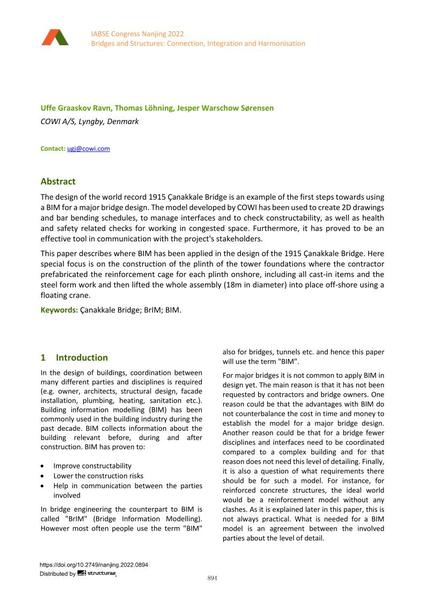The First Step Towards BIM Models in Major Bridge Design

|
|
|||||||||||
Bibliographic Details
| Author(s): |
Uffe Graaskov Ravn
(COWI A/S, Lyngby, Denmark)
Thomas Löhning (COWI A/S, Lyngby, Denmark) Jesper Warschow Sørensen (COWI A/S, Lyngby, Denmark) |
||||
|---|---|---|---|---|---|
| Medium: | conference paper | ||||
| Language(s): | English | ||||
| Conference: | IABSE Congress: Bridges and Structures: Connection, Integration and Harmonisation, Nanjing, People's Republic of China, 21-23 September 2022 | ||||
| Published in: | IABSE Congress Nanjing 2022 | ||||
|
|||||
| Page(s): | 894-901 | ||||
| Total no. of pages: | 8 | ||||
| DOI: | 10.2749/nanjing.2022.0894 | ||||
| Abstract: |
The design of the world record 1915 Çanakkale Bridge is an example of the first steps towards using a BIM for a major bridge design. The model developed by COWI has been used to create 2D drawings and bar bending schedules, to manage interfaces and to check constructability, as well as health and safety related checks for working in congested space. Furthermore, it has proved to be an effective tool in communication with the project's stakeholders. This paper describes where BIM has been applied in the design of the 1915 Çanakkale Bridge. Here special focus is on the construction of the plinth of the tower foundations where the contractor prefabricated the reinforcement cage for each plinth onshore, including all cast-in items and the steel form work and then lifted the whole assembly (18m in diameter) into place off-shore using a floating crane. |
||||
| Keywords: |
BIM BrIM Çanakkale Bridge
|
||||
| Copyright: | © 2022 International Association for Bridge and Structural Engineering (IABSE) | ||||
| License: | This creative work is copyrighted material and may not be used without explicit approval by the author and/or copyright owner. |
||||
